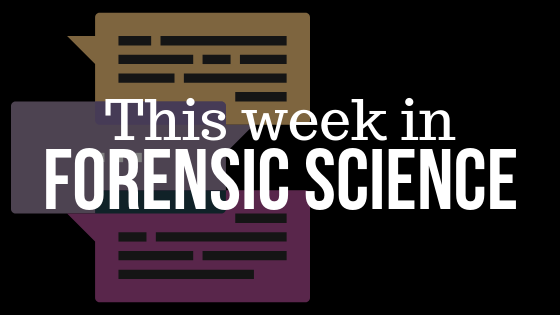No one has hours to scour the papers to keep up with the latest news, so we’ve curated the top news stories in the field of Forensic Science for this week. Here’s what you need to know to get out the door!
Marine Corps to Enhance Forensics Capability for Rapid Data Analysis (Naval Technology – 3/22/2019)
The US Marine Corps is upgrading its current forensics exploitation capability with new computing technology that can differentiate between allies and enemies on the battlefield.
DNA Testing Exonerates Dead Man in Florida Woman’s Murder 36 Years Later (ABC News – 3/22/2019)
- Ten years later, the reinvestigation into Harrison’s murder began when a written confession was handed over to law enforcement by the sister of Jack Harold Jones, a convicted murderer and rapist who was executed a year earlier by the state of Arkansas for the 1995 killing of Mary Phillips, 34.
Police: DNA Match IDs Killer in 1979 La Jolla Murder (kpbs – 3/22/2019)
A crime scene DNA match has, at long last, allowed homicide detectives to determine who stabbed a La Jolla mother of two to death at her home four decades ago, San Diego police announced Thursday.
After MIX13, Labs Must Revisit DNA Mixtures Across Country, Critic Argues (Forensic Magazine – 3/22/2019)
A federal study involving more than 100 crime laboratories came to that conclusion—six years ago. The “MIX13” study was published last year after some public criticism, and an April 2018 report by Forensic Magazine.
Now, the chief critic of the delay in publishing MIX13 says crime laboratories across the country should be undertaking wide-scale review of the questionable mixture cases using the latest computer software programs to get more accurate results.
DNA Analysis Identifies Pearl Harbor Sailor (Navy Times – 3/23/2019)
The military says scientists used advanced DNA and anthropological analysis, as well as circumstantial and material evidence, to identify Sadlowski.
Nationwide DNA Testing Backlog has Nearly Doubled, Despite $1 Billion in Federal Funding (Boston Globe – 3/23/2019)
For 15 years, the Justice Department has tried to reduce the backlog of crime scene DNA samples awaiting testing at state and local crime labs. But despite about $1 billion in federal spending to cut the number of untested cases, the number has grown by 85 percent in the past six years, according to a Government Accountability Office report.
Fluorescent Lights to Help Police Divers Find Human Remains (The Telegraph – 3/23/2019)
Researchers at the University of Huddersfield are trying to exploit the natural fluorescence of human bones through different light sources – using coloured filters – so they glow and become visible to forensic teams during land and water searches.
An Unsolved Homicide Haunted a City for Decades. Officials Say the Killer was There All Along. (The Washington Post – 3/26/2019)
The case haunted Billings for the next four decades, and investigators and family members would never stop chasing one simple, unanswered question: Who killed the Bernhardts?
Forty-five years later, they have an answer. And as it turns out, the alleged killer is dead, too.
Illumina to Sequence 10,000-Year-Old DNA to Find How Brain Disorders Began (FierceBiotech – 3/26/2019)
Illumina, taking a deep dive into the genetics of human history, plans to help map individual DNA fragments spanning thousands of years in a hunt for clues into today’s mental health issues and neurological conditions.
Illinois State Police to Launch Online Rape Evidence Tracking Tool (Forensic Magazine – 3/26/2019)
Survivors of sexual assault in Illinois will soon be able to monitor online the progress of DNA evidence related to their case, state police said.
Illinois State Police Director Brendan Kelly announced Sunday that the Division of Forensic Services will implement an online sexual assault tracking system by the end of the year.
Three Illicit Statues: What Next-Gen DNA Told Investigators (Forensic Magazine – 3/27/2019)
The three statues were found in rubble underneath a building in Vienna: the marble torsos of a man and a woman, and small head. Customs officers confiscated them and took them to a museum.
With few details to go on, the antiquities experts turned to the latest next-generation metagenomics analysis of the microbes on the contraband art to discover part of its provenance, as described in a paper dubbed a “Time Travel Story” in the Annals of Microbiology.
Research Provides Road Map to Combat Human Trafficking (Forensic Magazine – 3/27/2019)
More than 1,000 victims of human trafficking in Ohio have been identified thanks to a University of Cincinnati study published Tuesday, March 26, by the Ohio Department of Public Safety’s Office of Criminal Justice Services (OCJS). An additional 4,209 individuals were considered to be at risk of trafficking victimization during the same period.
After ‘Serial’ Podcast, Prosecutors Tested DNA Evidence in Adnan Syed Case. Here’s What They Found (Baltimore Sun – 3/28/2019)
The 1999 murder of Hae Min Lee became a national obsession with the hit podcast “Serial,” and home sleuths still debate the evidence online. DNA results wouldn’t make a splash, but a tidal wave.
WOULD YOU LIKE TO SEE MORE ARTICLES LIKE THIS? SUBSCRIBE TO THE ISHI BLOG BELOW!
SUBSCRIBE NOW!


